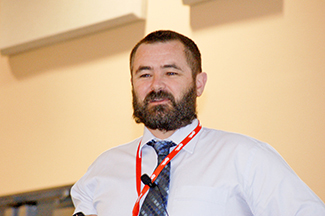Precision Livestock Management
Tracking cattle location and behavior, and managing the large sums of data, will pave the way for precision livestock management.
by Julie Mais, Angus Journal editor
BROOKINGS, S.D. (June 20, 2019) — Precision agriculture may be common in the cropping sector, but what happens when the philosophy, tools and systems are applied to livestock? Mark Trotter, Central Queensland University, is working to answer that question for Australia’s industries that rely on grazing.

Mark Trotter
As part of a precision livestock management group, Mark Trotter and his team consider efficiency, reducing cost while increasing production through utilizing tools like GPS trackers, satellite mapping and sensors. [Photo by Troy Smith]
“I saw that there's a lot of opportunities to take some of the thinking [in precision agriculture] and bring that into the grazing community, which hadn't progressed at the same rate as the comparable industries with precision agriculture,” Trotter said during the 2019 Beef Improvement Federation research symposium hosted June 18-21 in Brookings, S.D.
As part of a precision livestock management group, Trotter and his team consider efficiency, reducing cost while increasing production through utilizing tools like GPS trackers, satellite mapping and sensors.
“Our research is really given by matching a need or desired outcome with a technology focus thereafter,” he said.
The Australian beef industry ranks about seventh in the world, with 25 million head of cattle on the continent at any one time. In contrast to U.S. beef production, much of the slaughtered cattle in Australia are finished on grass — and Trotter said pasture utilization might be as low as 30%.
“If we could improve feed budgeting and matching stocking rates, both long- and short-term, to what's actually available on the ground, there's some real big opportunities to increase productivity,” he said.
Trotter said tracking cattle location and behavior, and managing the large sums of data, will pave the way for precision livestock management.
New developments in satellite-based sensing systems, as well as proximal sensors, he said, will deliver key information on the amount of grass available in pastures.
To monitor animal behavior, Trotter explained, in Australia there is excitement around the “smart ear tag” concept. A device on an animal ear tag gives you information, biometric information, and gives the location and behavior of the animal, then delivers that to your smartphone, tablet or computer. It provides you with remote access to the details of what's going on with your animal.
The key information he finds producers are interested in include location, behavior and biological state — health, reproductive activity, weight gain.
Trotter said producers were surveyed on how this type of information would affect profitability.
“It turns out there's a whole bunch of different applications out there that producers could use this for,” he said. “Everything from just knowing that animals are about to water, all the way through the calving, land detection, predatorial detection, and even some strange things like refining fertilizer application, landscape management and feed-base management.”
Trotter added that with this technology, it isn’t one single application that will draw uptake.
“We think in Australia at least, it's sort of a cumulative effect of all these little applications that sum up to a value proposition,” he concluded.
The 2019 BIF Annual Convention was hosted by South Dakota State University and the South Dakota Beef Breeds Council June 18-21 at the University Comfort Suites and Convention Center in Bookings. ANGUS MEDIA® provides comprehensive online coverage of the event at www.BIFconference.com. Visit the Newsroom for summaries, proceedings, PowerPoints, video and/or audio of the sessions and the Awards page for announcements and photos of award winners.
Editor’s Note: This summary was written under contract or by staff of ANGUS MEDIA®. Through an agreement with the Beef Improvement Federation,
we encourage reprinting of the articles to those who will adhere to the
reprint guidelines available on this site. Please review those
guidelines or contact Shauna Rose Hermel,
editor, at 816-383-5270. PowerPoints are posted with permission of the
presenter and may not be reproduced in whole or in part without the
express permission of the presenter. We welcome educational venues and
cattlemen to link to this site as a service to their audience.
For questions about this site, or to notify us of broken links, click here. Look for additional coverage in the Angus Journal, the Angus Beef Bulletin, the Angus Journal Daily, the Angus Beef Bulletin EXTRA and Angus TV.


